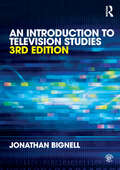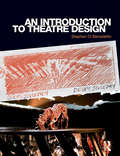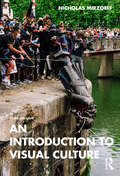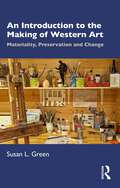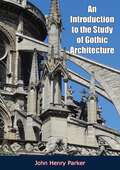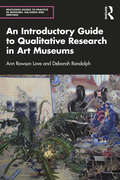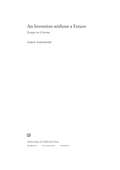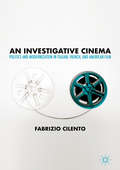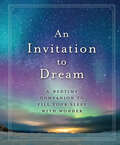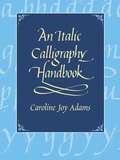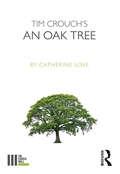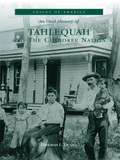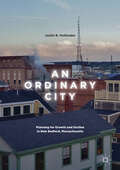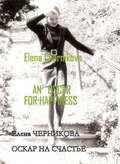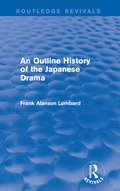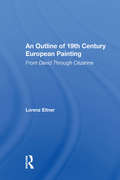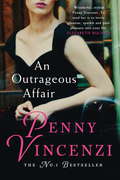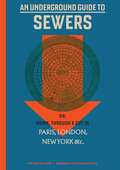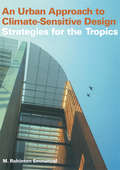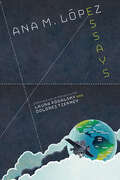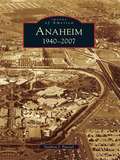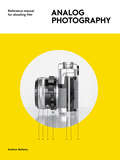- Table View
- List View
An Introduction to Television Studies
by Jonathan BignellIn this comprehensive textbook, now updated for its third edition, Jonathan Bignell provides students with a framework for understanding the key concepts and main approaches to Television Studies, including audience research, television history and broadcasting policy, and the analytical study of individual programmes. Features include: a glossary of key terms key terms defined in margins suggestions for further reading activities/assignments for use in class New and updated case studies feature: ‘Every Home Needs a Harvey’ ad approaches to news reporting television scheduling CSI Crime Scene Investigation animated cartoon series Individual chapters address: studying television, television histories, television cultures, television texts and narratives, television genres and formats, television production, television and quality, television realities, television you can’t see, television audiences, beyond television.
An Introduction to Theatre Design
by Stephen Di BenedettoThis introduction to theatre design explains the theories, strategies, and tools of practical design work for the undergraduate student. Through its numerous illustrated case studies and analysis of key terms, students will build an understanding of the design process and be able to: identify the fundamentals of theatre design and scenography recognize the role of individual design areas such as scenery, costume, lighting and sound develop both conceptual and analytical thinking Communicate their own understanding of complex design work trace the traditions of stage design, from Sebastiano Serlio to Julie Taymor. Demonstrating the dynamics of good design through the work of influential designers, Stephen Di Benedetto also looks in depth at script analysis, stylistic considerations and the importance of collaboration to the designer's craft. This is an essential guide for students and teachers of theatre design. Readers will form not only a strong ability to explain and understand the process of design, but also the basic skills required to conceive and realise designs of their own.
An Introduction to Visual Culture
by Nicholas MirzoeffIn the fully rewritten third edition of this classic text, Nicholas Mirzoeff introduces visual culture as visual activism, or activating the visible. In this view, visual culture is a practice: a way of doing, making, and seeing. The 12 new chapters begin with five foundational concepts, including Indigenous ways of seeing, visual activism in the wake of slavery, and unfixing the gaze. The second section outlines three currently successful tactics of visual activism: removal of statues and monuments; restitution of cultural property; and practices of repair and reparations. The final section addresses catastrophe and trauma, from Palestine’s Nakba to the climate disaster and the intersections of plague and war. Each section also includes new, in-depth case studies called "Visualizations," ranging from oil painting to Kongo power figures and the mediated practice of taking a knee. Engaging with questions of racializing, colonialism, and undoing gender throughout, this edition maps the activist turn in the field since 2014 and sets directions for its future expansion. This is a key text in visual culture studies and an essential resource for research and teaching in the field.
An Introduction to the Making of Western Art: Materiality, Preservation and Change
by Susan L. GreenThis book is the first introduction to Western art that not only considers how choice of materials can impact form, but also how objects in different media can alter in appearance over time, and the role of conservators in the preservation of our cultural heritage.The first four chapters cover wall and easel paintings, sculpture, drawings, and prints, from the late Middle Ages to the present day. They examine, with numerous examples, how these works have been produced, how they might have been transformed, and how efforts regarding their preservation can sometimes be misleading or result in controversy. The final two chapters look at how photography, new techniques, and modern materials prompted innovative ways of creating art in the twentieth century, and how the rapid expansion of technology in the twenty-first century has led to a revolution in how artworks are constructed and seen, generating specific challenges for collectors, curators, and conservators alike.This book is primarily directed at undergraduates interested in art history, museum studies, and conservation, but will also be of interest to a more general non-specialist audience.
An Introduction to the Philosophy of Art
by Richard EldridgeRichard Eldridge's compact survey of philosophical theories of the nature and significance of art draws on materials from classical and contemporary philosophy as well as literary theory and art criticism. Eldridge explores the representational, expressive, and formal dimensions of art, and argues that works of art present their subject matter as creations of enduring cognitive, moral, and social interest. His accessible study will be of interest to students and anyone interested in the relationship between thought and art.
An Introduction to the Study of Gothic Architecture
by John Henry ParkerThis popular and important textbook of Gothic architecture, first published in 1849, which ran to at least sixteen editions. The book is divided into the main body of the text, with mostly English examples of the various periods, and a section on foreign styles (French Gothic, Italian, Spanish, Swiss, Belgian, German).-Print ed.John Henry Parker CB (1 March 1806 – 31 January 1884) was an English archaeologist and writer on architecture and publisher.He was born in London, the son of John Parker, a merchant there. He was educated at Manor House School, Chiswick, and was apprenticed in 1821 to his uncle, the Oxford bookseller Joseph Parker (1774?–1850). He succeeded to his uncle's business in 1832, and ran the firm with great success, the most important of his publications being perhaps the series of the Oxford pocket classics.In 1836 he published his Glossary of terms used in Grecian, Roman, Italian, and Gothic architecture, which, published during the Gothic Revival in England, had considerable influence in extending the movement, and supplied valuable inspiration to young architects. In 1848 he edited the fifth edition of Thomas Rickman's Gothic architecture, and in 1849 he published a handbook based on his earlier volume entitled Introduction to the study of Gothic architecture. The completion of Hudson Turner's Domestic architecture of the Middle Ages next engaged his attention, three volumes being published (1853–60). He published Medieval architecture of Chester in 1858 and Architectural antiquities of the city of Wells in 1866.Parker was one of the chief advocates of the restoration of ecclesiastical buildings. In 1863 he and the Oxford Diocesan Architect G.E. Street revised plans for the restoration of St. Andrew's parish church, Chinnor. Parker also designed the triplet of traceried lancet windows in the chancel of St. Nicholas the Confessor, Forest Hill. His son James Parker (1832 or 1833–1912) also practiced as an architect.
An Introductory Guide to Qualitative Research in Art Museums (Routledge Guides to Practice in Museums, Galleries and Heritage)
by Ann Rowson Love Deborah RandolphAn Introductory Guide to Qualitative Research in Art Museums is a practice-based guide that is designed to introduce qualitative research to established and upcoming museum professionals and increase their confidence to conduct this type of research. Highlighting the work of researchers who are studying museums around the world, the book begins by explaining why there is a need for qualitative research in museums. Rowson Love and Randolph then go on to provide guidance, including theories and frameworks, on how to envision a qualitative research project that facilitates meaningful interpretation of visitor experiences. Chapters in the methodology section begin with descriptions of featured qualitative methodologies and will assist readers as they determine which are most appropriate for their projects and as they advocate for their research. The final section will prepare readers still further by demonstrating data analysis and reporting using the examples in the book. An Introductory Guide to Qualitative Research in Art Museums will help museum professionals and students engaged in the study of museums expand their repertoire to include qualitative methodologies and explain the methods needed to conduct, analyze, and report their qualitative research. It will be particularly useful to those with an interest in museum education, visitor studies and audience research, exhibition development, leadership, and management.
An Invention without a Future
by James NaremoreIn 1895, Louis Lumière supposedly said that cinema is "an invention without a future." James Naremore uses this legendary remark as a starting point for a meditation on the so-called death of cinema in the digital age, and as a way of introducing a wide-ranging series of his essays on movies past and present. These essays include discussions of authorship, adaptation, and acting; commentaries on Howard Hawks, Alfred Hitchcock, Orson Welles, Vincente Minnelli, John Huston, and Stanley Kubrick; and reviews of more recent work by non-Hollywood directors Pedro Costa, Abbas Kiarostami, Raúl Ruiz, and Apichatpong Weerasethakul. Important themes recur: the relations between modernity, modernism, and postmodernism; the changing mediascape and death of older technologies; and the need for robust critical writing in an era when print journalism is waning and the humanities are devalued. The book concludes with essays on four major American film critics: James Agee, Manny Farber, Andrew Sarris, and Jonathan Rosenbaum.
An Investigative Cinema: Politics and Modernization in Italian, French, and American Film
by Fabrizio CilentoThis book traces the development of investigative cinema, whose main characteristic lies in reconstructing actual events, political crises, and conspiracies. These documentary-like films refrain from a simplistic reconstruction of historical events and are mainly concerned with what does not immediately appear on the surface of events. Consequently, they raise questions about the nature of the “truth” promoted by institutions, newspapers, and media reports. By highlighting unanswered questions, they leave us with a lack of clarity, and the questioning of documentation becomes the actual narrative. Investigative cinema is examined in relation to the historical conjunctures of the “economic miracle” in Italy, the simultaneous decolonization and reordering of culture in France, the waves of globalization and neoliberalism in post-dictatorial Latin America, and the post-Watergate, post-9/11 climate in US society. Investigative cinema is exemplified by the films Salvatore Giuliano, The Battle of Algiers, The Parallax View, Gomorrah, Zero Dark Thirty, and Citizenfour.
An Invitation to Dream: A Bedtime Companion to Fill Your Sleep with Wonder
by Workman PublishingSweet Dreams Leave the busyness of the day behind and enter a world of enchantment. Pairing words from poets and writers with lush, romantic images—dusky forests and fresh-fallen snow, secret paths and rainy nights—every page of this soothing bedside companion is designed to put mind and body at ease before sleep, while inspiring the imagination to reflect, to discover, to wander, to dream.
An Italic Calligraphy Handbook (Lettering, Calligraphy, Typography)
by Caroline Joy AdamsAn updated version of the classic Renaissance manuals, this handbook is geared toward modern practitioners. It features the best ideas from the early guides, compiled into a contemporary system that makes writing the Italic as simple as possible. With this manual as a guide, both experienced and novice calligraphers can cultivate their natural creativity.
An Oak Tree
by Catherine LoveFirst Published in 2017. Routledge is an imprint of Taylor & Francis, an Informa company.
An Oral History of Tahlequah and The Cherokee Nation
by Deborah L. DuvallThese pages are filled with memories and favorite tales that capture the essence of life in the Cherokee Nation. Ms. Duvall invites the reader to follow the tribe from its pre-historic days in the southeast, to early 20th century life in the Cookson Hills of Oklahoma. Learn about Pretty Woman, who had the power over life and death, or the mystical healing springs of Tahlequah. Spend some time with U.S. Deputy Marshals as they roam the old Cherokee Nation in pursuit of Indian Territory outlaws like Zeke Proctor and Charlie Wickliffe, or wander the famous haunted places where ghost horses still travel an ancient trail and the spirits of long-dead Spaniards still search for gold.
An Ordinary City: Planning for Growth and Decline in New Bedford, Massachusetts
by Justin B. HollanderThis book paints an intimate portrait of an overlooked kind of city that neither grows nor declines drastically. In fact, New Bedford, Massachusetts represents an entire category of cities that escape mainstream urban studies' more customary attention to global cities (New York), booming cities (Atlanta), and shrinking cities (Flint). New Bedford-style ordinary cities are none of these, they neither grow nor decline drastically, but in their inconspicuousness, they account for a vast majority of all cities. Given the complexities of growth and decline, both temporarily and spatially, how does a city manage change and physically adapt to growth and decline? This book offers an answer through a detailed analysis of the politics, environment, planning strategies, and history of New Bedford.
An Oscar for Happiness: An Oscar for Happiness
by Nina Šoltić Elena ChernikovaThis is an autobiographical story. It covers the first years of the author's writing and creation.
An Ottawa Album: Glimpses of the Way We Were
by Marion Van de WeteringThis illustrated history of Ottawa traces the city’s development from the days when Bytown was a lumber village to its emergence as Canada’s capital and fourth-largest urban area. From the earliest photographs of the original Centre Block of the Parliament Buildings, through the VE-Day and VJ-Day celebrations at the end of World War II and beyond, this beautiful book of superb black-and-white photographs and informative text offers a charming glimpse of the evolving city. The photographs have been chosen both for their historical importance and their quality as visual art. They show a cross-section of life in the developing capital from the formality of Rideau Hall to working people selling wood and straw in Byward Market. This art, among the best from Canada’s early photographers, has been culled from major collections in the National Archives of Canada and Ottawa’s city archives. Many of the photographs have never been published before.
An Outline History of the Japanese Drama (Routledge Revivals)
by Frank Alanson LombardStudents of international drama are turning more and more to the study of Japanese drama, desirous to know to what extent its development duplicates or differs from the evolution of drama in other countries. Stimulated by the colour, originality, power, and poetry, they are interested to know more. This title, first published in 1928, traces the general development of the drama of the Japanese. This book will be of interest to students of drama, theatre studies and Asian Studies.
An Outline Of 19th Century European Painting: From David Through Cezanne
by Lorenz EitnerThis one-volume edition contains both text and plates and includes corrections in the text and bibliography made since the books publication in 1987. There are concise monographic chapters on the important artists and movements of the period, with material on each artists life and work, characteristics of style, and the relationship of the artistic movements to historical and intellectual currents of the time. The author covers a wide range of material and his presentation is lucid and perceptive. Neoclassicism, Romanticism, Realism, Academics and Salon Painters, and Impressionism are covered, and the following artists are included: David, Gros, Girodet, Grard, Gurin, Prudhon, Goya, Fuseli, Blake, Runge, Friedrich, Turner, Constable, Igres, Gricault, Delacroix, Corot, Rousseau, Daumier, Millet, Courbet, Manet, Degas, Monet, Renoir, Sisley, Pissarro, and Czanne.
An Outrageous Affair
by Penny Vincenzi'I defy any reader, once they've taken the smallest nibble, not to gobble it all down' Sunday ExpressIn wartime Suffolk, Caroline Hunterton fell in love. Now, decades on, that love becomes the only connection between a tragic Hollywood accident in the 1950s, and a terrible suicide twenty years later. Caroline has spent years trying to keep those secrets from her two daughters, Chloe and Fleur, who have been separated by the Atlantic and have grown up hating one another. But soon, their shared past may be all that can save the family... From rural England and Hollywood's glory days, to London's theatreland and New York's adland, An Outrageous Affair explores the many forms love takes, and how it can change us all.
An Underground Guide to Sewers: or: Down, Through and Out in Paris, London, New York, &c.
by Stephen HallidayA global guide to sewers that celebrates the magnificently designed and engineered structures beneath the world's great cities. The sewer, in all its murkiness, filthiness, and subterranean seclusion, has been an evocative (and redolent) literary device, appearing in works by writers ranging from Charles Dickens to Graham Greene. This entertaining and erudite book provides the story behind, or beneath, these stories, offering a global guide to sewers that celebrates the magnificently designed and engineered structures that lie underneath the world's great cities. Historian Stephen Halliday leads readers on an expedition through the execrable evolution of waste management—the open sewers, the cesspools, the nightsoil men, the scourge of waterborne diseases, the networks of underground piping, the activated sludge, the fetid fatbergs, and the sublime super sewers. Halliday begins with sanitation in the ancient cities of Mesopotamia, Greece, and Imperial Rome, and continues with medieval waterways (also known as “sewage in the street”); the civil engineers and urban planners of the industrial age, as seen in Liverpool, Boston, Paris, London, and Hamburg; and, finally, the biochemical transformations of the modern city. The narrative is illustrated generously with photographs, both old and new, and by archival plans, blueprints, and color maps tracing the development of complex sewage systems in twenty cities. The photographs document construction feats, various heroics and disasters, and ingenious innovations; new photography from an urban exploration collective offers edgy takes on subterranean networks in cities including Montreal, Paris, London, Berlin, and Prague.
An Unofficial Encyclopedia of Strategy for Fortniters: Duos and Squads Strategies (Encyclopedia for Fortniters)
by Jason R. RichIn addition to the Solo game play mode (which pits each gamer up against up to 99 others in a real-time battle), the Duos mode allows gamers to team up with one friend in a quest to defeat all other gamers during a match. Meanwhile, the Squads mode allows teams of four players to enter into a match and work together as they battle against up to 96 other gamers. The Duos and Squads game play modes are permanent features built into the game, and they’ve proven to be extremely popular, since Fortnite: Battle Royale is, for the most part, cross-platform compatible. Thus, someone experiencing the game on a PS4 can team up with a PC user, for example, to play against a random section of other gamers, in real-time. An Encyclopedia of Strategies for Fortniters: Duos and Squads Strategies will be the first book in this unofficial strategy guide series to offer in-depth coverage of Fortnite: Battle Royale’s team-oriented game play modes. Thus, this unofficial strategy guide will be chock full of proven strategies and game play tips designed to help teams achieve victory in the Fortnite: Battle Royale matches they participate in. This expanded (approximately 176-page) guide will include a comprehensive overview of the Fortnite: Battle Royale game, with a special focus on the game’s team-oriented game play modes. The full-color book will appeal to readers age 8 and up, regardless of which gaming platform they’re using. Throughout each match, gamers must: Focus on survival Avoid the deadly storm Explore the island Gather resources Build structures and fortresses Find, collect, and utilize weapons and ammunition Acquire and use loot items Engage in combat against enemy soldiers with the goal of becoming the last person alive at the end of the match When experiencing any of the team-oriented game play modes, cooperative gameplay (teamwork) and communication with team members become vital. An Encyclopedia of Duos and Squads Strategies will soon be an indispensable resource for gamers experiencing the Duos or Squads game play modes (or any of the other team-oriented game play modes added to Fortnite: Battle Royale on a temporary basis).
An Urban Approach To Climate Sensitive Design: Strategies for the Tropics
by Rohinton EmmanuelThe need to respond to the rapidly changing city climate is particularly urgent in the tropics where the urban transition is currently at its peak. While the need is clearly felt by the tropical urban dwellers, texts that provide an overview of the problem and indicate possible design solutions are rare. This comprehensive reference will be welcomed by student and practising architects as well as other built envronment professionals engaged with the environmental effects of building in worldwide warm and humid climates.
Ana M. López: Essays (SUNY series in Latin American Cinema)
by Ana M LópezAna M. López is one of the foremost film and media scholars in the world. Her work has addressed Latin American filmmaking in every historical period, across countries and genres—from early cinema to the present; from Brazil, Cuba, and Mexico to diasporic and Latinx cinemas in the United States; from documentary to melodrama to politically militant film. López's groundbreaking essays have transformed Latin American film studies, opening up new approaches, theoretical frameworks, and lines of investigation while also extending beyond cinema to analyze its connections with television, radio, and broader cultural phenomena. Bringing together twenty-five essays from throughout her career, including three that have been translated into English for this volume, Ana M. López is divided into three sections: the transnational turn in Latin American film studies; analysis of genre and modes; and debates surrounding race, ethnicity, and gender. Expertly curated and edited by Laura Podalsky and Dolores Tierney, the volume includes introductory material throughout to map and situate López's key interventions and to aid students and scholars less familiar with her work.
Anaheim: 1940-2007
by Stephen J. FaesselAfter the developments that the World War II era brought to the small agricultural community of Anaheim, the major transformation arrived in 1955. Anaheim changed forever from a sleepy and proud little town into the center for entertainment and tourism in Southern California with the arrival of Disneyland. Other national and regional businesses and franchises arrived in and around this Orange County anchor city--including the California Angels baseball club, the Anaheim Convention Center, and such aerospace giants as Boeing and Rockwell International--and Anaheim grew exponentially. This collection of more than 200 vintage and contemporary images depict the results of Anaheim's far-sighted elected and business leaders, who nurtured the city from its agrarian roots and made it into one of the nation's fastest growing cities in the 1960s.
Analog Photography: Reference Manual for Shooting Film
by Andrew BellamyAttracted by the image quality, the tactile joy of a finely made camera, and the affordable prices of vintage equipment, photographers around the world are rediscovering the joys of manual photography. This comprehensive guide to shooting film photography covers all the bases, from setting up a camera through film processing. In a convenient format, filled with diagrams, examples, and illustrations, Analog Photography is a portable reference tool for neophytes and experienced photographers alike. With an irresistible package inspired by the aesthetics of vintage user manuals, this is "a great-looking publication and a fantastic place from which to start, or rekindle, a journey into film photography" (Creative Review).
